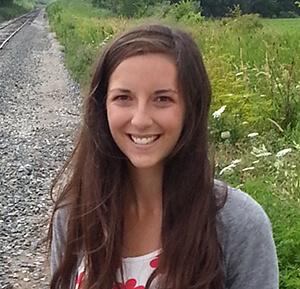In this issue of IMPACT, meet Ashley Brien, a Master's candidate in Communications Sciences and Disorders, a program in UVM's College of Nursing and Health Sciences.
IMPACT: Tell our readers a little bit about where you are from and what your undergraduate studies focused on.
AB: I am from Holland, a small town in northern Vermont with a population of approximately 600 people. I attended UVM as an undergraduate student where I majored in English and Psychology. I initially studied psychology because I wanted to provide support to those people who maybe needed extra guidance in their life to make healthy life choices. Halfway through my undergraduate career, I picked up English as a second major because I really enjoyed writing, studying aspects of grammar, and studying literature.
IMPACT: What inspired you to go to graduate school at UVM?
AB: It was really two different events that inspired me to pursue the Communication Sciences and Disorders Master’s program at UVM. First, throughout my undergraduate career, I worked with a young woman with cognitive impairments, who also had a severe hearing loss. We instantly became very close and I spent almost all of my time outside of class either at her house or on an outing with her. I eventually began bringing her to “speech class” (as she called it), and helped her to complete her “speech homework” outside of the therapy sessions. I became interested in helping her to become aware of the speech sound errors she was making when she was less focused on her speech, and she was very receptive to my support. During my time with this young woman, I also learned some basic sign language, which reinforced my interest in communication and the development of these skills.
The second event happened after graduating from UVM as an undergraduate in the winter of 2011. I was hired at an elementary school in St. Albans where I worked in the school’s autism program as a para-educator. I worked with a variety of children with Autism Spectrum Disorder (ASD), ranging from Kindergarten to 3rd grade, who all had different levels of communication and communication needs. A handful of the kids with whom I worked were nonverbal and required intensive social, language, and communication support, while others had age-appropriate language skills, but were unable to use those language skills in ways that were socially appropriate. It was through spending my days with these children and supporting their communication skills, whether it be through speech, sign language, or an augmentative communication device, that confirmed my desire to become a Speech-Language Pathologist, particularly in the realm of working with people on the autism spectrum.
IMPACT: Very interesting. Tell us about your experiences in grad school -- what it's like to work with faculty members and to do your own scholarship or research.
AB: Graduate school at UVM has presented me with a variety of wonderful opportunities that are unique to this university. In addition to taking courses that are preparing me for life after grad school, I have been able to work with a number of our clinical faculty members through evaluations and treatment sessions for clients receiving services at the Eleanor M. Luse Center (UVM’s clinic for hearing and speech/language services). The clinical faculty have pushed me to develop my own critical thinking strategies, as well as provided me with invaluable resources that I can use throughout my career.
Through UVM’s Communication Sciences and Disorders (CSD) Master’s program, I have had the opportunity to work with a variety of children and adults, including those with apraxia of speech, expressive and receptive language disorders, fluency disorder, intellectual disability, autism, Down syndrome, aphasia, hearing impairments, as well as neurotypical children and adults.
Doing my own research is fascinating! To study something that has yet to be studied by anyone else is really cool. My Master’s thesis research is being conducted with Tiffany Hutchins, Ph.D., and uses eye-tracking technology to examine the factors that predict mouth-looking versus eye-looking in children with ASD via a Skyped conversation. I'm also looking at the eye-versus mouth-looking behaviors of children with ASD and comparing them to those of typical children. Running the data and finding significant correlations is really exciting!
IMPACT: Has your work resulted in any publications or papers and have you had the opportunity to go to any conferences or other professional events?
AB: To date, I have not published any papers. My hope is that, after I defend my thesis this year, my research will be published and prompt other researchers to expand on my study and develop intervention strategies and techniques based on my findings.
I attended the Autism Summer Institute this summer where I heard presenters Philip S. Strain, Ph.D., Sherry Sancibrian, M.S., and Jennifer Stapel-Wax, Psy.D., speak on a variety of topics relevant to current research and intervention strategies for children with ASD.
In November, I'm attending Harvard Medical School’s “Autism Spectrum Disorders” conference.
IMPACT: Where are you currently in your graduate education and what are your plans after graduation?
AB: I will be graduating from the CSD Master’s Program in May of 2015. My hope is to be hired at an elementary school where I can work mainly with children on the autism spectrum. After an unspecified amount of time, however, I hope to return to school and earn my Ph.D.
Finally, I love all animals and one day hope to incorporate animals into my practice, through Animal Assisted Therapy.
